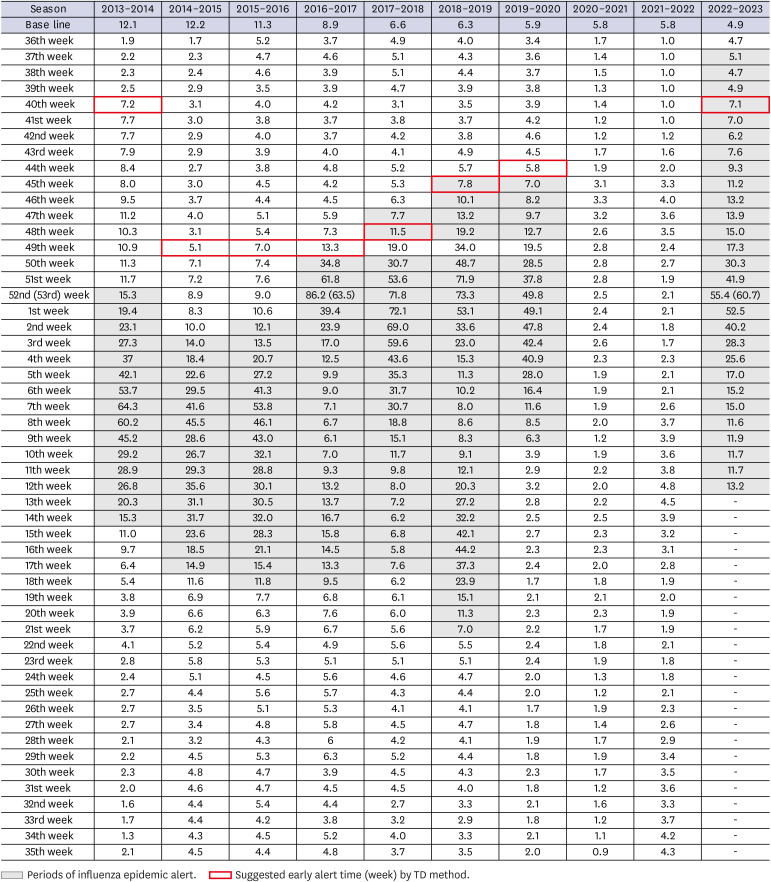J Korean Med Sci.
2024 Jan;39(4):e40. 10.3346/jkms.2024.39.e40.
Application of the Time Derivative (TD) Method for Early Alert of Influenza Epidemics
- Affiliations
-
- 1Division of Infectious Disease Control, Bureau of Infectious Disease Policy, Korea Disease Control and Prevention Agency, Cheongju, Korea
- 2Research Team for Transmission Dynamics of Infectious Disease, Division of Fundamental Research on Public Agenda, National Institute for Mathematical Sciences, Daejeon, Korea
- KMID: 2551970
- DOI: http://doi.org/10.3346/jkms.2024.39.e40
Abstract
- Background
In order to minimize the spread of seasonal influenza epidemic to communities worldwide, the Korea Disease Control and Prevention Agency has issued an influenza epidemic alert using the influenza epidemic threshold formula based on the results of the influenza-like illness (ILI) rate. However, unusual changes have occurred in the pattern of respiratory infectious diseases, including seasonal influenza, after the coronavirus disease 2019 (COVID-19) pandemic. As a result, the importance of detecting the onset of an epidemic earlier than the existing epidemic alert system is increasing. Accordingly, in this study, the Time Derivative (TD) method was suggested as a supplementary approach to the existing influenza alert system for the early detection of seasonal influenza epidemics.
Methods
The usefulness of the TD method as an early epidemic alert system was evaluated by applying the ILI rate for each week during past seasons when seasonal influenza epidemics occurred, ranging from the 2013–2014 season to the 2022–2023 season to compare it with the issued time of the actual influenza epidemic alert.
Results
As a result of applying the TD method, except for the two seasons (2020–2021 season and 2021–2022 season) that had no influenza epidemic, an influenza early epidemic alert was suggested during the remaining seasons, excluding the 2017–2018 and 2022–2023 seasons.
Conclusion
The TD method is a time series analysis that enables early epidemic alert in real-time without relying on past epidemic information. It can be considered as an alternative approach when it is challenging to set an epidemic threshold based on past period information. This situation may arise when there has been a change in the typical seasonal epidemic pattern of various respiratory viruses, including influenza, following the COVID-19 pandemic.
Keyword
Figure
Reference
-
1. Korea Disease Control and Prevention Agency. Epidemiology and Management of Infectious Disease. 1st ed. Cheongju, Korea: Korea Disease Control and Prevention Agency;2021. p. 475–482.2. Korea Disease Control and Prevention Agency. 2022-2023 Season Influenza Management Guideline. Cheongju, Korea: Korea Disease Control and Prevention Agency;2022.3. Choe YJ, Lee JK. The impact of social distancing on the transmission of influenza virus, South Korea, 2020. Osong Public Health Res Perspect. 2020; 11(3):91–92. PMID: 32494566.4. Nazareth J, Pan D, Martin CA, Barr I, Sullivan SG, Stephenson I, et al. Is the UK prepared for seasonal influenza in 2022-23 and beyond? Lancet Infect Dis. 2022; 22(9):1280–1281. PMID: 35932777.5. Kwak JY. Nationwide movement after distancing was lifted, higher than before COVID-19. TBS NEWS [Internet]. Updated May 11, 2022. Accessed May 5, 2023. http://tbs.seoul.kr/news/newsView.do?seq_800=20461881&typ_800=6 .6. Lee NJ, Woo S, Lee J, Rhee JE, Kim EJ. 2021-2022 Influenza and respiratory viruses laboratory surveillance report in the Republic of Korea. Public Health Wkly Rep. 2023; 16(20):53–65.7. Cha J, Seo Y, Kang S, Kim I, Gwack J. Sentinel surveillance results for influenza and acute respiratory infections during the coronavirus disease 2019 pandemic. Public Health Wkly Rep. 2023; 16(3):597–612.8. Korea Disease Control and Prevention Agency. Weekly sentinel surveillance report. Update 2023. Accessed May 5, 2023. https://npt.kdca.go.kr/npt/biz/npp/portal/nppPblctDtaView.do?pblctDtaSeAt=2&pblctDtaSn=3123 .9. Centers for Disease Control and Prevention. U.S. Influenza surveillance: purpose and methods. Updated October 14, 2022. Accessed May 5, 2023. https://www.cdc.gov/flu/weekly/overview.htm .10. Son WS, Park JE, Kwon O. Early detection of influenza outbreak using time derivative of incidence. EPJ Data Sci. 2020; 9(1):28. PMID: 32934899.11. Cowling BJ, Wong IO, Ho LM, Riley S, Leung GM. Methods for monitoring influenza surveillance data. Int J Epidemiol. 2006; 35(5):1314–1321. PMID: 16926216.12. Steiner SH, Grant K, Coory M, Kelly HA. Detecting the start of an influenza outbreak using exponentially weighted moving average charts. BMC Med Inform Decis Mak. 2010; 10(1):37. PMID: 20587013.13. Castillo-Chavez C, Chen H, Lober WB, Thurmond M, Zeng D. Infectious Disease Informatics and Biosurveillance. New York, NY, USA: Springer Science;2011.14. Won M, Marques-Pita M, Louro C, Gonçalves-Sá J. Early and real-time detection of seasonal influenza onset. PLOS Comput Biol. 2017; 13(2):e1005330. PMID: 28158192.
- Full Text Links
- Actions
-
Cited
- CITED
-
- Close
- Share
- Similar articles
-
- Influenza
- The Preparedness Plan for Influenza Pandemic
- Using an influenza epidemic threshold different from those in the United States and Europe caused longer epidemic periods in Korea during the 2018– 2019, 2019–2020, and 2022–2023 seasons: a comparative study
- Overview of Pandemic Influenza
- The National Influenza Surveillance System of Korea




